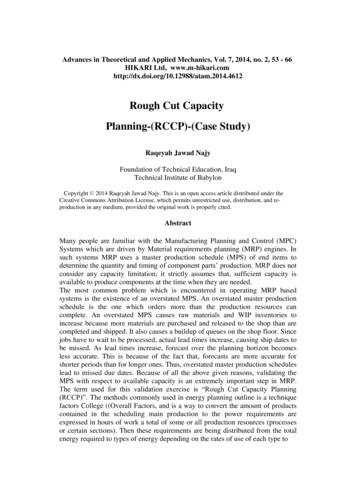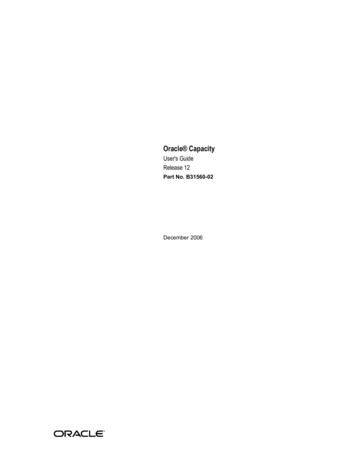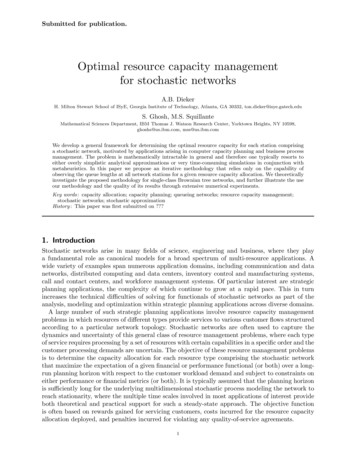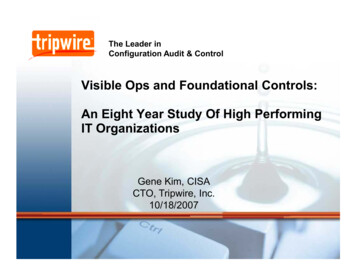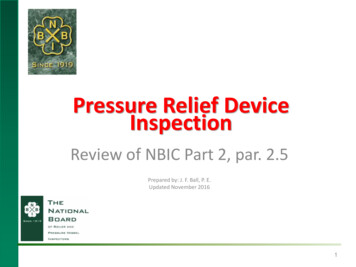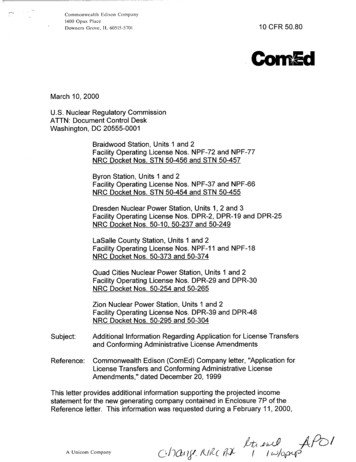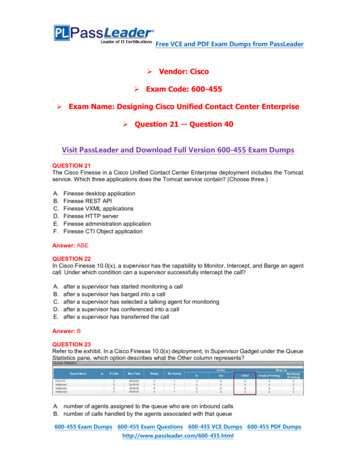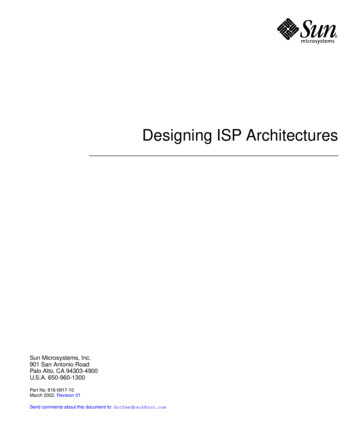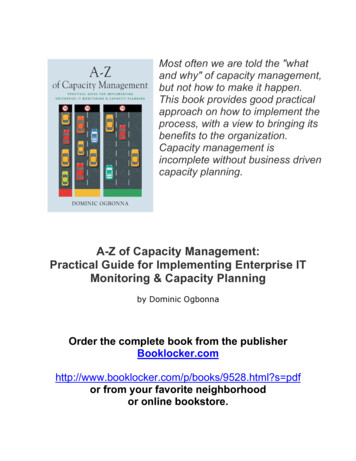
Transcription
Most often we are told the "whatand why" of capacity management,but not how to make it happen.This book provides good practicalapproach on how to implement theprocess, with a view to bringing itsbenefits to the organization.Capacity management isincomplete without business drivencapacity planning.A-Z of Capacity Management:Practical Guide for Implementing Enterprise ITMonitoring & Capacity Planningby Dominic OgbonnaOrder the complete book from the /books/9528.html?s pdfor from your favorite neighborhoodor online bookstore.
Copyright 2017 Dominic OgbonnaISBN 978-1-63492-757-4All rights reserved. No part of this publication may be reproduced, stored in aretrieval system, or transmitted in any form or by any means, electronic,mechanical, recording or otherwise, without the prior written permission of theauthor.Published by BookLocker.com, Inc., St. Petersburg, Florida.Printed on acid-free paper.Booklocker.com, Inc.2017First Edition
TABLE OF CONTENTSForewordxiAcronymsxiiiPrefacexvWhy I wrote this bookxvWho should read this bookxviBook OrganizationxviiConventions Used in this BookxixAcknowledgementsxxi1 Capacity Management - Issues, Goals, and Benefits1Introduction1Benefits of Capacity Management2How does Capacity Management need arise?4Common Errors in Implementing the Capacity Mangemenmt Process5Capacity Management versus Capacity Planning8Components of Capacity Management8Summary11Organizational Appraisal112 Capacity Management Strategy13Introduction13Capacity Management Maturity Model14How to determine Assets In-Scope for Capacity Management17v
DOMINIC OGBONNAHandshake with other IT Processes19Capacity Management Organization & Stakeholders26Basic Requirements for Capacity Management Compliance27Capacity Management Team Organization28Summary29Organizational Appraisal293 Capacity Management Gap Analysis & KPIS31Capacity Management Gap Analysis31Capacity Management - Key Performance Indicators (KPIs)38Summary39Organizational Appraisal404 Monitoring and Resource Data Collection41Introduction41Application Performance Issue - the root cause43Common Capacity Management Metrics44System Resource Utilization Overview47Resource Data Collection Technologies49Resource Data Collection Methods51Resource Limitation Types – Physical and Application54Summary58Organizational Appraisal595 Business Metrics Data Collection Techniques61Introduction61Business Metrics, Classifications, and types62Business Metrics Identification Techniques67Business Metric Data Source Types70Business Metrics Data Collection Format73Determining Business Metric Capacity Limit & SLA78Performance Testing79Performance Testing Types81Summary84vi
A-Z OF CAPACITY MANAGEMENTOrganizational Appraisal846 Data Aggregation Methods & Granularity87Introduction87Data Aggregation Methods87Derived Metrics94Data Aggregation Granularity/Resolution95Summary97Organizational Appraisal987 Capacity Database (CDB) & Data Storage TechniquesIntroduction9999Implementing Capacity Database (CDB/CMIS)100CDB Data Aggregation Implementattion Strategy: Hard Vs Soft101CDB Data Repository Implementation Strategy: Separate vs. Combined106Summary109Organizational Appraisal1108 Capacity Reports111Introduction111Capacity Reports types by Audience112Capacity Report - Display Options Compared117Summary128Organizational Appraisal1299 Capacity Planning131Introduction131Capacity Planning Inputs132Capacity Planning Model - Forecasting Service & Resource135Capacity Planning Prediction Methods138Correlation - Establishing Relationship Between Datasets142Correlation Analysis Using Microsoft Excel143Summary148Organizational Appraisal14810 Building Analytical Capacity Planning Modelvii149
DOMINIC OGBONNAIntroduction149Modelling Objective150"A2Z" Storage System Model - Performance Restraint Resources151Modelling Approach153The Modelling Assumptions154Information from Historical Metrics155Business Demand Forecast157Service Demand Forecast160Resource Utilization Forecast162Infrastructure Forecast164Capacity planning for Shared IT Infrastructure Resources170Critical Success Factors for Capacity Planning Model170Summary171Organizational Appraisal17211 Capacity Planning Review with Stakeholders173Introduction173Review Audience174Capacity Metrics Validation & Draft Capacity Plan Review174Capacity Planning Model and Draft Capacity Forecast Review175Summary176Organizational Appraisal17612 The Capacity Plan177What is Capacity Plan?177Contents of a Capacity plan178Summary184Organizational Appraisal18513 Capacity Threshold Alerting & Response Types187Introduction187What is Threshold Alerting188Categories of Threshold Alerting189Alert Messages192viii
A-Z OF CAPACITY MANAGEMENTSummary194Organizational Appraisal19514 Cloud Computing Capacity Management197Introduction197Cloud Computing Capacity Management - the Open Questions199Cloud Computing Capacity Management – What to Expect200Capacity Management in Machine Learning era201Summary202Organizational Appraisal20315 Auditing the Capacity Management Process205Introduction205Key Control Objectives206Scope206Control Requirements207Summary209Organizational Appraisal210Appendix A – UNIX: Performance Data Collection Techniques211Introduction211vmstat Utility211sar Utility214iostat Utility217Appendix B - Windows: Performance Data Collection Techniques219Logman.exe219Glossary of Terms225ix
FOREWORDCapacity Management is a bedrock of application stability. Collecting theappropriate metrics, understanding the data and reacting in a timely manner canavoid outages or at least reduce the time taken to fix an issue. This book will teachyour organization how to ensure metrics are designed from the beginning of theSoftware Development Lifecycle and deployed to production to collect thenecessary insight into the environment.One of the common misnomers for capacity management is all metrics are drivenfrom the infrastructure. Dominic provides critical insight into how understanding thebusiness needs and capturing the expected profiles drives teams to make betterdecisions. For example, a set of servers running at100% CPU utilization might look likea problem - unless those same servers are the batch processing systems or gridcomputing nodes designed for computational analysis. In this case, capacitydecisions would be driven by business expansion or volume/timing and theavailable headroom left on the servers to run more computations.Dominic has written a thoughtful and detailed book on planning capacity metricsto provide insightful views to your business cases. He provides both the theory of thecapacity management processes and the practical implementation that is so oftenoverlooked - using real-world examples and the specific commands. Having seenDominic's suggestions in practice, the techniques are invaluable to the organizationimplementing them.Megan RestucciaFormer Executive Director at Morgan Stanleyxi
PREFACEWHY I WROTE THIS BOOKMost often we are told the "what and why" of capacity management, but not howto make it happen.This book provides good practical approach on how toimplement the capacity management process, with a view to bringing its benefitsto the organization.The subject of capacity management is now treated like a theoretical process, andas an oral tradition which has lost its right content. It is now common knowledgethat a good number of trainers in this process do not understand the basicconcept, how much more offering a practical insight.This book provides a detailed guideline for practical implementation of thecapacity management process, with a view to demystify the managementprocess; a move from theory to practice - using a simple capacity managementmodel that can fit into organizations of any size.Repeatedly, I have seen individuals and organizations very keen on implementingcapacity management correctly, but inadvertently, they end up doing it wrongbecause, traditionally, the focus is just on monitoring and alerting based on the hostserver resources usage - CPU utilization, Memory utilization, etc. This book seeks toclarify the process and expose the readers to a simplified way to doing it right, whileadding value to the organization through capacity management process.xv
DOMINIC OGBONNAThe full benefit of implementing the capacity management process is usuallyharnessed when it operates as a value-added process within the organization. Thiswill be possible when the process maturity level is well above average.Capacity management can hardly be accomplished solely by the capacityanalysts/manager working alone; to get its implementation right, this book outlinesboth the technical and business stakeholders that should be involved. It alsocontains questions you should ask regarding most IT service/application to ensureyou are monitoring the right business and service data.WHO SHOULD READ THIS BOOKThis book is for anyone who wants to have an in-depth knowledge of how toimplement capacity management process in an organization, and those whosefunctions or services involve mitigating business risk associated with IT service failure.From a technology point of view, CIOs, CTOs, capacity managers, capacityanalyst, capacity planners, business and technical service owners, IT operationsmanagers, service managers , IT and business consultants, IT auditors and riskofficers, operation engineers, business managers, senior business managers,application architects and developers, infrastructure support analysts, etc. will findthis book very insightful, and useful.Furthermore, CEO, and senior business leaders who are interested in deliveringexcellent service to customers, but with focus on reducing IT Infrastructure spendingwill also find this book very rewarding.xvi
PREFACEBOOK ORGANIZATIONThis book is organised into chapters based on the capacity management processmodel diagram, with each chapter describes how to practically implement theprocess. In addition, each chapter has conclusion, success hints and organizationalappraisal questions; that are designed to help the reader evaluate the processimplementation within their organization.Chapter 1, What is Capacity Management, introduces capacity management, itsgoals and benefits, and the need to use business data to drive capacity planningrather than basing it on infrastructure resource usage.Chapter 2, Capacity Management Strategy, dwells on the guidelines for puttingthe proper policy and procedure in place to drive the capacity managementprocess.Chapter 3, Capacity Management Gap Analysis & KPIS, provides an overview ofwhat to look out for when assessing the current state of the process, and how tomeasure the success of the capacity management process.Chapter 4, Monitoring and Resource Data Collection, provides ways to go aboutcollecting system resource performance data.Chapter 5, Business Metrics Data Collection Techniques, provides deep dives forbusiness metric instrumentation, and how to determine the business metricscapacity limits.Chapter 6, Data Aggregation Methods & Granularity, provides guidelines fortransforming the collected metric data to meet the capacity management needs.xvii
DOMINIC OGBONNAChapter 7, Capacity Database (CDB) & Data Storage Techniques, provides theinformation that will help towards building scalable and high performanceCDB/CMIS.Chapter 8, Capacity Reports, looks at the report audience and what they need toknow.Chapter 9, Capacity Planning, gives in depth guidelines on how to get started withcapacity planning, and the basic inputs and tools required.Chapter 10, Building Analytical Capacity Planning Model, an extensive guideline forbuilding capacity planning models, and a step by step description of a samplemodel.Chapter 11, Capacity Planning Review with Stakeholders, covers how to get thebusiness users’ co-operation in the capacity planning.Chapter 12, The Capacity Plan, guide to writing formal capacity plan document.Chapter 13, Capacity Threshold Alerting & Response Types, introduces effectivethreshold breach management.Chapter 14, Cloud Computing Capacity Management, reviews the place ofcapacity management in the cloud computing and machine learning era.Chapter 15, Auditing the Capacity Management Process, how to ensure thecapacity management process is kept on track and fit for purpose.Appendix A, UNIX Server Performance Data Collection Techniques, focuses onvmstat, sar, and iostat; and turning their output to csv format.xviii
PREFACEAppendix B, Windows Server Performance Data Collection Techniques, overview ofLogman.exe for performance metrics collectionCONVENTIONS USED IN THIS BOOKThe following typographical conventions are used in this book:ItalicIndicates quotes from people, formulae, command-line optionsItalic BoldIndicates text that should be replace by the user with the appropriate valuesxix
1 CAPACITY MANAGEMENT - ISSUES, GOALS, AND BENEFITS“Facts do not cease to exist because they are ignored”– Aldous Huxley.INTRODUCTIONCapacity management is the information technology risk management process forensuring there is adequate infrastructure and computing resources to meet thecurrent and future demand of the business in a cost effective and timely manner.This management process primarily seeks to proactively ensure that applicationsand infrastructures have the ability to provide the resources required to meet theorganization's current and future business demand needs in a cost-effective andtimely manner. Capacity management is also a risk management technique forensuring that an IT service meets SLA target in a cost effective and timely manner.It is one of the processes defined in the Information Technology InfrastructureLibrary (ITIL ) framework, and belongs to the Service Design phase of servicelifecycle. Within an organization, the maturity level for implementing capacitymanagement can vary for different IT services used by the business depending ontheir criticality to the business.A desired maturity level is where the capacity management process can beproactively applied to support the business' current and future demand without1
DOMINIC OGBONNAreacting or fire-fighting to restore IT service outage or performance degradationarising from inadequate IT resources to cope with the business demand. This impliesthat to attain this maturity level, capacity planning will not only be driven by thecurrent utilization of the IT infrastructure resources, but also by how the futuredemand of the business will affect the infrastructure resources utilization.Resultantly, at this level of capacity management maturity level, capacity isrepresented using terms that the business users understand, and not technicaljargons.Capacity management is not only about having adequate infrastructure resourcesfor business, it is also about right-sizing and cost-savings; by ensuring that excesscapacity provisions are detected and retracted.Having a good capacity management process in place is not an antidote forpreventing IT service incidents, because IT service outage or performancedegradation could arise from other sources - human, coding, or IT changemanagement errors, etc. As a result, the capacity management process keyperformance-indicators (KPIs) should be based on eliminating incidents withcapacity risk as the root cause.BENEFITS OF CAPACITY MANAGEMENTCapacity management brings about the goal of right-sizing the application andinfrastructure resources, by aligning the current and future business demand at theright cost. There are several other benefits associated with it when correctlyimplemented, amongst these are:2
DOMINIC OGBONNA Makes it easy to transfer infrastructure and computing resources fromplaces of excess capacity to where needed, without additional spend Capacity management helps in the development of the applicationperformance testing function within an organization Increases customer or end-user experience satisfaction, loyalty, andretention Provides data needed for incident investigation, and problem root causeanalysis.HOW DOES CAPACITY MANAGEMENT NEED ARISE?The need for capacity management has arisen because IT infrastructure andcomputing resources are limited in supply; increasing these resources will usuallyinvolve the organization parting with money. In contrast to the limited resources,the demand for them increases as the business grows.As a result, capacitymanagement deals with balancing IT infrastructure, computing, and processingresources along: Cost of getting resources versus resource capacity available Supply by IT providers versus demand by business users.These are further illustrated below.Practical illustration:You have an application that can allow up to 1000 online buyers logins at the sametime, and operates with performance service level agreement of login averagecompletion time of within 3 seconds. The cost of upgrading the application to4
CAPACITY MANAGEMENT - ISSUES, GOALS, AND BENEFITSmaintain the stated service level agreement is 5000 for each additional 100 buyerlogins.Cost versus Capacity scenario If the current capacity is 1000 (maximum logins) Any attempt to increase the concurrent logins beyond the current capacityof 1000 will require spending more money - a cost to the business Increasing IT processing capacity always has cost implication for theorganization. The cost could be both fixed and recurring.Supply versus Demand scenario If the current capacity is 1000 If the monthly peak concurrent buyer-logins over the last 6 months is 200, itwill make sense to reduce the capacity, and increase it as demandincreases. (this will not only save the business money, it may also reduceother licensing costs associated with this application) If on the other hand, the business as a result of new marketing plan informsyou that in 6 months time, it expects the buyer-logins to increase byadditional 500.At this point, you will need to increase the capacity toaccommodate the expected demand increase, however, you need tocarry out a planned upgrade close to the expected demand increase Increase or decrease in business demand of an IT service should translate toIT infrastructure resources supply upgrade or downgrade respectively.COMMON ERRORS IN IMPLEMENTING THE CAPACITY MANGEMENMT PROCESSThere are some common mistakes often made while implementing the capacitymanagement process they should be avoided if you desire to get the full benefitsof the process.5
DOMINIC OGBONNA No single capacity planning model will be a fit-for-all applications or systems For infrastructure resource utilization or service latency, the maximumaggregated value is good for monitoring the system heart beat andincident investigation. However, it is not good for capacity planning. Theresource utilization spikes could come from system panic, bad databasequeries, system command, application bug, or other unexpected sources.As a result, using the maximum aggregation method, a single or transientspike in resource utilization will erroneously be taken as the value of theperiodic data set, rather than getting the peak utilization incurred over asustained time interval. This will lead to infrastructure over provisioning orexcess capacity which is a cost to the organization Like above, the average value is also wrong because it obscures the realhigh utilizations over the period interval. This will lead to infrastructure underprovisioning or inadequate capacity which is a cost to the organization Modelling infrastructure resource utilization, for example, ‘Total CPUutilization’ using trend line will lead to inaccurate planning, because suchresources' response time will no longer operate linearly once the CPU isoverloaded Capacity planning based on only Infrastructure resources utilization maynever be representative of the business volumes and throughput drivingyour infrastructure capacity, and will lead to inaccurate planning Business capacity metrics without performance measurements, (throughputand latency), will not be able to provide the needed end-user perceptionof the IT service Capacity Planning should be carried out based on peak trading periodmetrics In data collection the focus should be on measuring resource used, and notresource available. Capacity management is about reporting, andplanning based on resource utilization Collecting resource data for which there is no known capacity limit orspecifiedavailable maximum capacity will not be useful in capacity6
DOMINIC OGBONNACAPACITY MANAGEMENT VERSUS CAPACITY PLANNINGUsually the terms ‘capacity management’ and ‘capacity planning’ are usedinterchangeably, this is not right. In summary, capacity planning is a subset orcomponent of capacity management. Capacity plan is the output from thecapacity planning component; and implementing the capacity plan is the endproduct of proactive capacity tionwiththebusinessusers/representatives that provide their business demand forecasts as an input tothe process; which in turn predicts the infrastructure requirement to meet the futurebusiness demand.Capacity management adds value to organizations when it can proactively helpmitigate service performance degradation or outage relating to inadequateinfrastructure resources.At the lower maturity level of capacity management, there may not be explicitcapacity planning process in place, rather the IT support team relies oninfrastructure utilization threshold alerting, and users’ IT-service-failure complaints.This approach is reactive, and leads to fire fighting for service restoration.COMPONENTS OF CAPACITY ormationtechnologymanagement process has building blocks, or components. The key components ofthe capacity management process are shown below in Figure 1.1 (Dominic's modelof the capacity management process diagram); each of the components will be8
DOMINIC OGBONNAFigure 1.1 Capacity Management Process Diagram - Dominic's ModelEach of these components or group of components is discussed in detail in thesubsequent chapters.10
CAPACITY MANAGEMENT - ISSUES, GOALS, AND BENEFITSSUMMARYThe capacity management process is an IT service risk management technique,which should be given adequate attention, so as to ensure that service failure orperformance degradation arising from inadequate infrastructure resources isproactively and cost effectively eliminated. This can happen when: In this digital age, customers can easily switch service, capacitymanagement should be seen as a business enabler, not only as cost centre Organizations should embrace the capacity management process, andgive it the needed senior management support. Capacity management should not be seen as just reacting and fixingcapacity issues arising from infrastructure resource threshold breachalerting. It should be proactive, by focusing on the business capacity driverswhich are causing the resources usage to increase. The capacity management process is incomplete without the capacityplanning component, which makes the process proactive. The capacity management process is also aimed at reducing the cost ofdoing business, by eliminating excess infrastructure provisioning, licenses,and other associated costs.ORGANIZATIONAL APPRAISAL1. Is capacity management process implemented in your organization?2. Is the capacity management implementation yielding the expectedbenefits?3. Is capacity planning part of your capacity management process activities?4. Is your capacity management process determined by business volumetricor just system resource utilizations?11
MONITORING AND RESOURCE DATA COLLECTIONcapacity management - proactive capacity planning (to predict futureinfrastructure resources needed to support the business demand forecast), thethree sub processes should be used together in a capacity model.APPLICATION PERFORMANCE ISSUE - THE ROOT CAUSEThe necessity for capacity planning has arisen to combat the performanceproblems that users experience when using an IT system/application, whichsometimes makes such application unusable. It is important to know what gives riseto this performance problem.Figure 4.2, shows the typical response of infrastructure resource or device toconcurrency request types, one example of such device is the CPU. This resourceresponse pattern is what is eventually translated to the external applicationresponse, which the end-users experience.Figure 4.2 CPU Response Time vs. Load/Throughput/Queue BehaviourBased on Figure 4.2, it can be seen that:43
DOMINIC OGBONNA The Response time increases as the users' requests increase (e.g. more usersrequesting a system resource at the same time) More user demand leads to additional load, and additional load leads toincreased request throughput As the throughput increases such that the device cannot respond to all request,the request queue gets increased As the queue continue to increase, the device may become unresponsive; andat this point, users will wait almost indefinitely (this state is popularly described byusers as 'the system is hanging') SLA is breached when the response time stops responding linearly One key objective of the capacity management process is to ensure that thereare adequate resources to share the load, so that the application will alwaysoperate within the SLA acceptance region.COMMON CAPACITY MANAGEMENT METRICSThere are common metrics associated with each of the three sub processes ofcapacity management. In this section, we will focus more on the resource andservice metrics that are generic. The business sub process metrics are not genericin nature, but vary for each IT application; therefore, detailed guideline will beprovided for it in chapter four.Table 4.3 Common(continued) CapacitySubProcessesResource /InfrastructureManagementMetrics TypeCommon MetricsHost/ServerCPU Utilization (Total), CPU Utilization (User),CPU Utilization (System), CPU Utilization(IOWAIT), Queue Length, Memory utilization,44
5 BUSINESS METRICS DATA COLLECTION TECHNIQUES“The secret of getting ahead is getting started”- Mark Twain.INTRODUCTIONIn the previous chapter, business metrics was briefly introduced and explained,nonetheless, this chapter is dedicated to further discussing this very important andpivotal component of business capacity management.For an organization’s capacity management maturity level to operate in the“value” position, her forecast of IT infrastructure and computing requirementsshould be driven by the following: The ability to measure and express the actual business activities performed byan IT system in business terms The business representatives should be able to provide the business demandforecast in business terms Capacity reports meant for senior management, and business stakeholdersmust be expressed in business terms.61
BUSINESS METRICS COLLECTION TECHNIQUESBUSINESS METRICS IDENTIFICATION TECHNIQUESAs part of the process of collecting business metrics, the application businessowners or their representatives (IT system owners/managers/architects) should beconsulted to ensure that the appropriate business metrics are collected. After all,the demand forecast data that is required for capacity planning will have to comefrom the application business owner.Sometimes, the application business owners or their representatives may not bevery clear about how to determine the most appropriate business metrics to beincluded for data collection. Guidance can be provided using the “question andanswer” technique outlined below:Table 5.2 (continued)Business Metrics Identifier Questions & AnswersProbe QuestionTypical AnswerTypical Identification Analysis1. What doesThe applicationThe likely volumetric business metricsthereceives customerfrom the stated key end-userapplication ororders, sends outactivities based on the providedsystem do?request messagesanswer are:and acceptsRequest messages, Uploaded filesuploaded filesand Customer ordersNote: The identified volumetricbusiness metrics will also have serviceperformance throughput metrics.2. How do youdetermineThe time it takes toThe likely performance metrics -deliver the requestresponse time or latency are:67
7 CAPACITY DATABASE (CDB) & DATA STORAGE TECHNIQUES“If you only have a hammer, you tend to see every problem as a nail”- Abraham MaslowINTRODUCTIONCapacity management depends essentially on collecting and analyzing data.Therefore, the process, success will depend largely on properly storing the data,and the ease of accessing, analyzing, reporting and extracting the data. The datastorage component of the capacity management process system tool is identifiedby different names, amongst them are: Capacity Database (CDB), or CapacityInformation management System (CMIS); we use the name tagged as CDB.The method adopted in storing the metrics in the database plays a vital role in theusability, reliability, reporting flexibility, and scalability of the CDB system.For organizations that choose to implement a commercial / third party solution, thismay not be given serious attention; conversely, the reverse is the case fororganizations building, and implementing an in-house solution.99
DOMINIC OGBONNAIMPLEMENTING CAPACITY DATABASE (CDB/CMIS)The Capacity Database (CDB) is an ITIL version 2 (in ITIL version 3, it is calledcapacity Management information System (CMIS)) term used to describe the datarepository that holds capacity management process data. It includes but is notlimited to business, service, and resources actual metrics from IT services in scope.Also stored in CDB are: metrics capacity limit, SLA, metrics’ alert usage threshold,business forecast data, and modelling parameters.Even though CDB by nomenclature is referred to as "database", it is just a repositorywhich can be implemented using a relational database system (RDBMS),spreadsheet, no-SQL database, etc. Irrespective of the implementation, minimally,it should be able to support the generation of
This book provides good practical approach on how to implement the process, with a view to bringing its benefits to the organization. Capacity management is incomplete without business driven capacity planning. A-Z of Capacity Management: Practical Guide for Implementing Enterprise IT Monitoring &a
